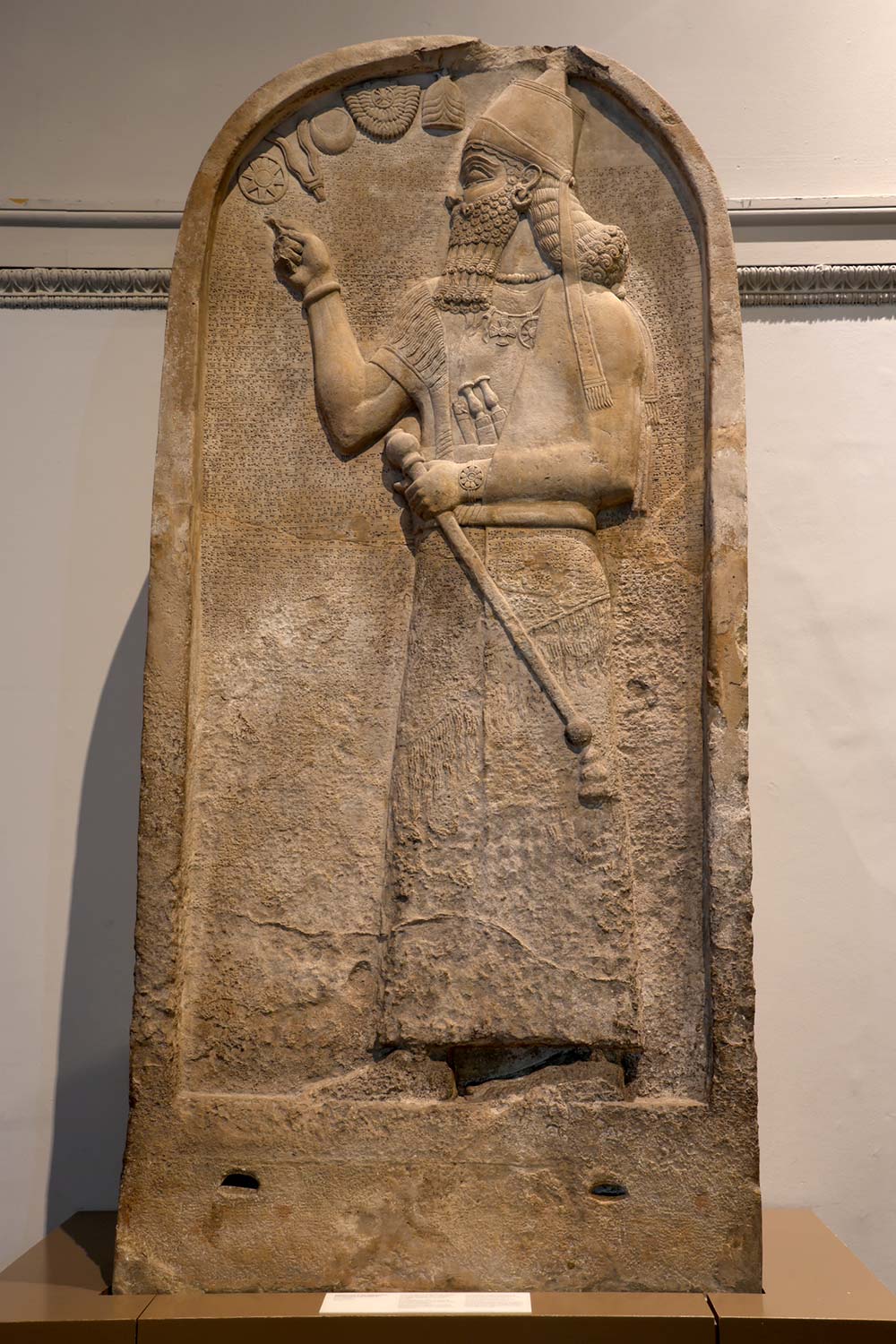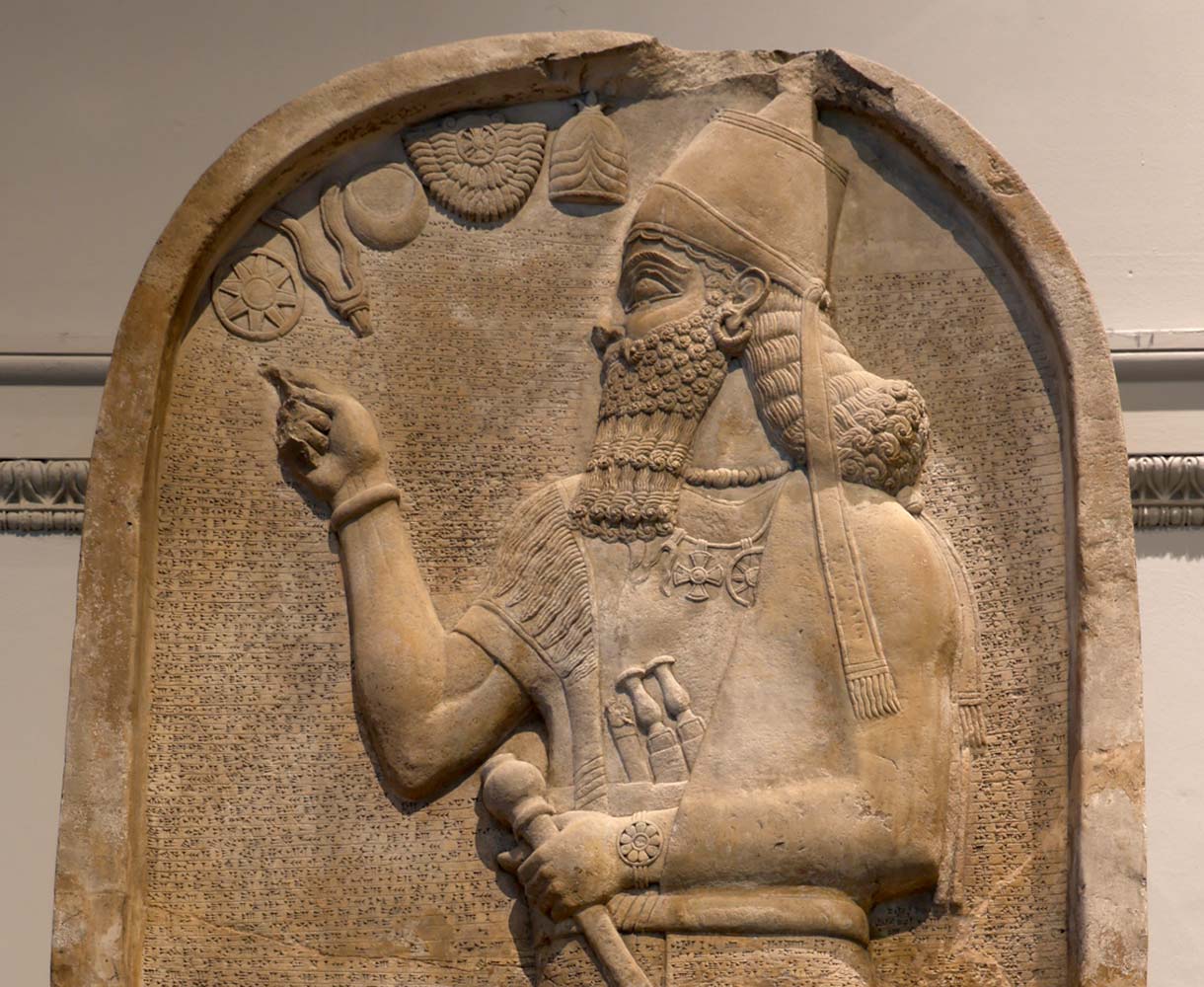
Ashurnasirpal II was a very powerful Assyrian king in the early to mid 800s BC (reigned 883BC – 859BC). He is not directly connected to the Bible but he and his son Shalmaneser III (reigned 859BC – 824BC) ruled Assyria for almost 60 years, building it into the war machine that would dominate the area known as Mesopotamia, modern-day Iraq. The British Museum considers the Assyria of 900BC – 600 BC to be the world’s first empire, where an empire is one person or government ruling over multiple countries.
Ashurnasirpal can be translated as “Ashur is the guardian of the heir“. Ashur is the top god of the Assyrian pantheon. Thus, the king’s name invokes the protection of this most important god. All ancient kings had the name of a god in their name.
The king stands before five symbols of his gods. His right hand is in the gesture of a finger snap as a sign of respect. From left to right, the gods are:
- Ishtar: goddess of love and war, represented by a wheel (actually, a star)
- Adad: storm god, represented by a lightning fork
- Sin: moon god, represented by a crescent moon
- Shamash: sun god, represented by a winged disk emanating rays
- Ashur: war god, represented by a horned helmet

Additional symbols of the gods hang around his neck including the moon god (partial crescent moon), storm god (lightning fork), sun god (Maltese cross) and the love and war goddess (partial star). He wears a symbol of a flower on his left wrist, which stands for protection and good luck. The pommels of two daggers are tucked into his cloak.
The Assyrians believed that the left side of the face was the inferior side, and that the right side was superior. Ashurnasirpal shows us his left side in order to demonstrate that he is inferior to the gods. In most of his imagery, when he faces people, especially enemies and lions, he shows the right side of his face, indicating that he is superior.
We see this right-hand dominance in the Bible where there are numerous references to right-handedness.
In Isaiah 41:10, God reassures Israel:
“So do not fear, for I am with you;
do not be dismayed, for I am your God.
I will strengthen you and help you;
I will uphold you with my righteous right hand.”
In Genesis 48, Joseph brings his sons Manasseh (older) and Ephraim (younger) to his father Jacob to be blessed. Manasseh is supposed to get the right hand while Ephraim is supposed to get the left hand. But instead, Jacob crosses his hands to bless Ephraim with his right hand and Manasseh with his left.
Joseph is unhappy with this but Jacob assures him that this is intentional.
Later on, the tribe of Ephraim became so prominent that it was the dominant tribe of the northern Kingdom of Israel. Isaiah prophesies, “Ephraim’s jealousy will vanish, and Judah’s enemies will be destroyed; Ephraim will not be jealous of Judah, nor Judah hostile toward Ephraim.” in Isaiah 11:13. Ephraim stands for the entire northern kingdom.
The entire piece is covered with cuneiform, the writing of the day. When writing was first invented, scribes used a reed stylus on wet clay, imprinting wedges, triangles, diamonds and lines. This led to modern scholars labelling the writing as “cuneiform“, from the Latin for “wedge shaped“.
While the writing is called cuneiform, the language of Assyria was Akkadian, a popular language. Cuneiform was also used for the Sumerian and Old Persian languages.
The Akkadian language has been deciphered, and we can read King Ashurnasirpal’s inscriptions praising himself and documenting his actions.
“At that time, my kingship, my dominion, (and) my power came forth at the command of the great gods. I am king, I am lord, I am praiseworthy, I am exalted, I am important, I am magnificent, I am foremost, I am a hero, I am a warrior, I am a lion, and I am virile…” Humility was not one of his strengths.
In other words, everything about him was positive, exceedingly positive, and nothing embarrassing.
Further down, he wrote: “I dyed the mountain red like red wool with their blood (and) the ravines (and) torrents of the mountain swallowed the rest of them. I carried off captives (and) possessions from them. I cut off the heads of their fighters (and) built (therewith) a tower before their city. I burned with fire their adolescent boys (and) girls.”
The Assyrian kings believed that all people had to obey the god Ashur. In order to demonstrate that obedience, they had to obey the king and if they were not obeying the king, they had to be forced to. Thus, the kings went out on campaign every year to force everyone to obey the king, and hence Ashur. A lot of people died, at least according to the poetic inscriptions.
Of another campaign he wrote: “ I brought back captives, possessions, oxen, (and) sheep from them (and) burned with fire their cities. I hung their heads on trees of the mountain (and) burned with fire their adolescent boys.”
In four of his campaigns, he uses the curious phrase, “grasp my feet”: “ [I massacred many of them, carried off prisoners (and) possessions from them, (and) burned with fire th(ose) cities]. The troops, [as many as had fled from my weapons, came down (and) grasped my feet. I imposed upon them corvée].”
Grasping the feet was the expression for bowing as low as possible so that the inferior person could hold on to the feet of the superior person.
This practice of going out on campaign every year for many years would build Assyria into the war machine that would dominate the area from 912BC to 612BC.
The extremely cruel violence was done to intimidate the surrounding countries into surrendering without a fight. News of this ferocity travelled far and wide. This psychological warfare ensured much less fighting and easier domination, at least in the short run.
Given how warlike they were, we can see why God would use Assyria to destroy the sinful and disobedient Kingdom of Israel.